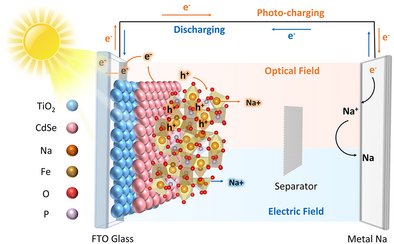Photogenerated Holes Induced Deep Sodium Storage of TiO2/CdSe/NFPP Cathode for High-Efficiency Photorechargeable Sodium Batteries
Graphical Abstract
Dual-functional TiO2/CdSe/NFPP cathode was designed for photorechargeable sodium batteries. Photogenerated holes from CdSe migrate to NFPP, facilitating efficient sodium deintercalation. The holes-absorbed film-forming agent FEC on NFPP causes a thin NaF-rich cathode electrolyte interphase, which effectively suppresses electron tunneling and electrolyte decomposition. The PRSBs deliver high capacity and conversion efficiency (4.34%).
Abstract
Resource-friendly photorechargeable sodium batteries (PRSBs) integrate energy storage devices with solar cells, offering a promising path for sustainable energy. Herein, a novel TiO2/CdSe/Na3Fe2(PO4)P2O7 (NFPP) cathode was prepared layer-by-layer utilizing resource-abundant commercialized NFPP and photoactive CdSe. The aligned energy levels with type II band structure ensure effective transfer of photogenerated holes from CdSe (−5.71 eV) to higher valence band of NFPP (−5.10 eV). Experimental results reveal that, during charging, the induced holes in NFPP accelerate the transition of Fe2+ to Fe3+ with a change of O–Fe hybrid orbitals. The calculations of bond valence sum and energy distribution reveal that NFPP-holes possesses broad Na+ transport path with reduced transport barrier (from 0.512 to 0.428 eV), improving Na+ extraction efficiency. Additionally, photogenerated holes could regulate surface charge distribution on NFPP and thus form a film-forming agent fluoroethylene carbonate (FEC)-dominated electric double layer. Finally, it converts to a thinner (9.75 nm illumination) NaF-rich cathode interphase layer, avoiding subsequent excessive electrolyte decomposition. As a result, the NFPP under illumination delivers high capacity of 119.1 mAh g−1 at 1 C, showing 41.11% improvement compared to dark conditions.
Conflict of Interests
The authors declare no conflict of interest.
Open Research
Data Availability Statement
The data that support the findings of this study are available from the corresponding author upon reasonable request.





